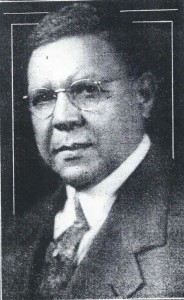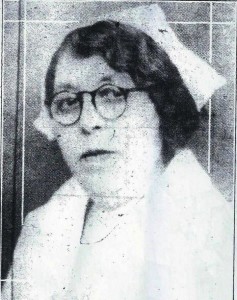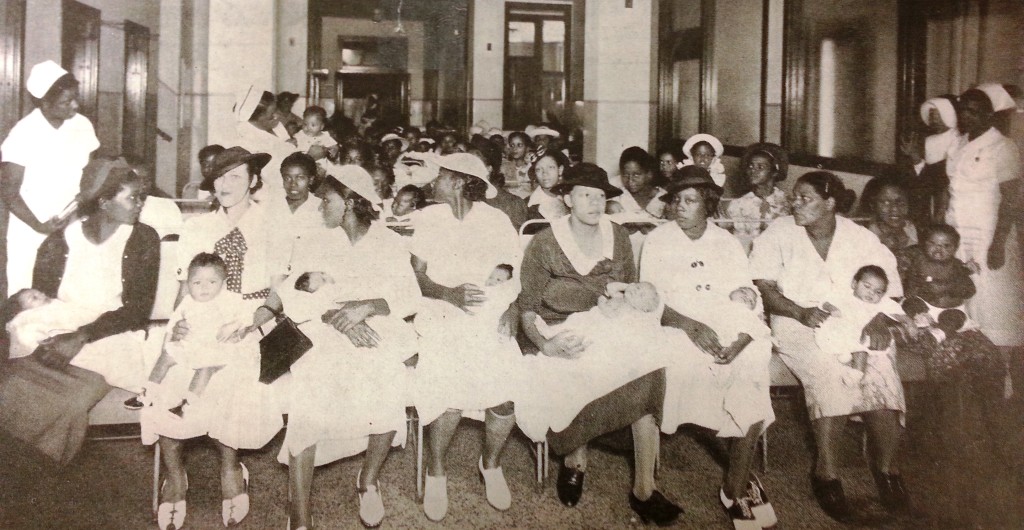
Dr.Raleigh J. Coker (1885-1953)
One of the most difficult tasks for black physicians living in the Jim Crow South was their ability to attract patients of their own race. Since they were excluded from treating whites; black physicians had to compete with midwives, folk healers, patent medicines, and white doctors for patients. Having been shut out of segregated hospitals, office buildings, and medical societies (click here for more info). These doctors often had to treat patients in inferior facilities. Many prosperous blacks often preferred white doctors since many thought they were better trained and operated better facilities. Of course, white doctors were usually more than willing to attend to them as long as they could pay. As a result, black physicians had to find other means to attract patients into their care.
One means of attracting patients was to enter into contracts with insurance agencies. In 1906, the state of Louisiana passed a law defining insurance companies as organizations with agents to collect weekly premiums and issue policy contracts. However, since most people of color were unable to afford ordinary life and health insurance policies, and white companies were unwilling to insure them at the same rates as whites, this created an excellent opportunity (click here) for black entrepreneurs in the South.
For a small weekly premium, black insurance companies could afford their clients benefits for sickness, accidents, and death. These insurance companies were a source of racial pride since they were black-owned businesses in the South and its agents were black professionals or semi-professionals. By 1930 there were nine life insurance companies opened by people of color in New Orleans, employing 72 percent of the city’s black office workers.
Such was the case with Dr. Raleigh J. Coker. He was hired by The Unity Industrial Life Insurance Company throughout the 1920s to be medical director of its New Orleans health clinics. In view of the high mortality rate among infants, the company decided to expand clinic services in Algiers and several other cities with Dr. Coker and a registered nurse, Mrs. Alice Bachemin, as his assistant.
These clinics were opened weekly to policyholders and non-policy holders alike. While they focused largely on health education and preventive medicine- especially for expectant mothers and young children- they also treated minor injuries, ailments, and provided free vaccinations. Free clinics run by insurance agencies, of course, had an ulterior motive- to attract new clients- but they still provided a necessary service to those who needed it.
Ads in The Louisiana Weekly listed the Unity Insurance Building as being located at 535 South Rampart Street with branches at 2017 Dryades Street, 1016 North Claiborne Avenue, and throughout the state.
Mrs. Alice Bachemin (1885-1963)
Throughout his medical career, Dr. Coker always had Mrs. Alice V. Bachemin, a registered nurse, as his assistant. They were also close neighbors both living at 1415 and 1421 Dumaine Street for many years.
Dr. Raleigh Coker was born in New Orleans about 1885 to Dr. J. H. Coker and Pauline Boutte Coker. His siblings were Maude, Ethel, Ruth, Thurman and Byron Coker. Raleigh Coker attended primary grades in N.O. Public Schools and classes at New Orleans, Southern and Walden Universities, before graduating from Meharry Medical College of Tennessee in 1909. He married Emily Allen who passed away in 1932. He later married Idell Duplessis and raised an adopted daughter, Miss Antonia Bossier.
Alice Bachemin (1885- 1963) was also born in New Orleans and became a registered nurse. She married Alfred Bachemin and had one daughter, Vera Bachemin and one son, Fabio Bachemin. Vera later married Arnold Rillieux and together they had one biological daughter, Janine Rillieux Sylve. They also raised Marguerite Rillieux Parent, Arnold’s daughter from a previous marriage to Carmen Rillieux, who died in childbirth. Alice died just 2 months after her daughter, Vera, on 23 Nov. of 1963.
Besides Unity Industrial, Dr. Coker was also appointed Medical Examiner of National Industrial from 1924- 1928 and Supreme Life Insurance in the 1940s. Statistics in the 1930s showed that out of every 1,000 live births, there were 45 deaths among babies within the first month, which later increased to nearly 100 in the first year. This appalling mortality rate demonstrated the great need for education and training of mothers during pregnancy and after the birth of the child.
One of the most important events to the medical profession in New Orleans was the opening of Flint- Goodridge Hospital in 1932 (click here). Its importance cannot be overstated. It was here where Dr. Coker and other black physicians were provided with a place to treat their patients. Black physicians controlled Flint Hospital. They were on all committees, were provided with continuing educational training and served in total capacities as doctors.
“Well- Baby” Clinic/ Flint- Goodridge Hospital (1939)
It was here that Dr. Coker, along with sixteen other physicians, served on the gynecology and obstetrics staff of the hospital. Here, babies were delivered by physicians instead of midwives. Since the infant-mortality rate throughout Louisiana in the 1930s was 54 per-cent higher among Negro babies than white ones, mothers were encouraged to bring their babies to the “well-baby” clinic at Flint each month for inspection and advice.
A hired social worker organized mothers’ clinical visits and saw to it that every baby born on the hospital’s wards returned to the “well-baby clinic” once a month for one year for general observations and proper instructions to the mother as to the proper care of her child.
Dr. Coker was just an example of all those black physicians who struggled under very harsh conditions to serve their people at a very critical time in our history. I salute them for the work they did and hope this article will help to instill to all our readers the important contributions they made throughout our communities.
For further reading, I highly recommend Thomas J. Ward’s book, “Black Physicians in the Jim Crow South” published by the University of Arkansas Press in 2003.
Sources: Black Physicians in the Jim Crow South, Thomas J. Ward (2003); Amistad Research Center, Dent Family Papers & Am. Missionary Assn. Records; The Baltimore Afro-American, 17 Jan. 1931 p. 18; The Times- Picayune, 20 March 1953; The Louisiana Weekly 11 June 1932 p.1 + 18 January 1936 p.1 + 21 March 1953; Philadelphia Tribune, 1 March 1928 p.14. (A special thanks to Melvin Parent for providing information on Alice Bachemin, his step great- grandmother and on Dr. Raleigh Coker)
Lolita V. Cherrie





Miss Antonia Bossier was the principal for many years at McDonough #42 on N. Tonti St. in the 7th Ward. Dr. Coker’s adopted daughter.
Yes, you are so correct!! Antonia Bossier’s obituary states that she was also principal at Rosenwald, Thomy Lafon, as well as McDonogh #37and #6. She was also listed in “Who’s Who in American Women and received the Order of St. Louis from the Archdiocese of N.O. in 1991.She passed away in February of 1994 and was buried from Corpus Christi Church and St. Louis Cemetry #3. Thanks so much, Castro, for all the great comments you share with us…Lolita
I was a student at Mc 42 when Ms. Bossier was principal. It was the first year the school was opened for blacks. Euphamie Williams who lived on Duels and Republic was also my teacher. We did not have books, and when we did receive them, they were so old, however we never stopped learning. Under Mrs. Williams I wrote my first play. There was a fish pond on the right hand side of the school step entrance which in a few years was covered in mud. No one would ever know a fish pond was on the site.
Miss Bossier was my principal when I was in 5th grade when I attend McD. #42. She also was my grandfather (Leonard Allen’s) 1st cousin by adoption.Her mother was my great grand-aunt Emily Allen-Coker, the older sister of my great great grandfather Samuel J.Allen who’s mother and father was George and Leontine Braud-Allen.
I wish to express my thanks to Lolita Cherrie for her extensive research and dedication to providing little known history of Black people in the South and in particular the New Orleans area.
Was his daughter. Maude principal of Craig School?
Very interesting article.
Hi Stephanie, You’re probably thinking of Maude Dedeaux Crocker who was principal of Joseph Craig Elementary for many years. Crocker sounds similar to Coker, but they are two totally different individuals. Thanks for asking….Lolita
Maude Dedeaux Crocker was my great-aunt by marriage. She was married to Laurence Crocker, the namesake of Crocker Elementary School. Laurence Crocker the brother of my maternal grandfather, Lionel Crocker. Mary Crocker, Lionel’s daughter, was my mother, who was married to William John Huntley, Jr. I am their daughter, Ann Huntley Drysdale, living and working in California’s Bay Area for the last 20 years as an attorney.
Great article, it’s good to know our history as stated in the article. We can note that necessity is the mother of invention and the need to build a practice was provided by the organization of insurance companies. In our need for same services, such as medical, we can follow the same course. As the saying goes, history repeats itself; one might argue that it deletes itself also. This is truly Black History.
My great grandfather George Louis Allen founded Great Liberty Ins Company that was on St.Bernard Ave and N.Robertson St across from the Circle Food Store this was back in 30’s or 40’s.He was the nephew of Emily Allen-Coker and the 1st cousin to Mrs Antonia Bossier.
I was reading the article thinking it was interesting history, but there was no one I knew nor recognized until I came to the name of Antonia Bossier. They say we are all connected and I believe that is true. Antonia Bossier was my neighbor on Roman Street. She lived in a duplex with Albert and Bella Taylor on the other side. Bernadine Villavasso visited there often. All of those years and a very close connection with our family I had no idea Antonia was adopted. She never spoke of her family. She was a very lovely, elegant woman who was well respected in New Orleans.
Cookie where are you Contact me please
I still have pics of the beautiful yellow bassinet u made for Edward.
Actually it was on Old Roman St just off old London Ave.
I am trying to find information on a black Dr. Eugene A Lindsay who lived in Opelika, Al and practice medicine there in the 1930 and 1940 Nees information
I have a early photograph of my great grand-Aunt Emily Allen-Coker,but don’t know how to post it.Can anyone help me?
Alex, If you can scan Mrs. Coker’s picture and send it to me at Lolitac454@aol.com, I would be more than happy to post it on our site. If you don’t know how to do this, I’m sure you can find someone who does. Please feel free to reach me at the above email with any further questions….Lolita
Vera B. Rillieux is buried with my Grandfather, Fabio Bachemin (May 18, 1905 to January 3, 1934). Were they siblings? My father was also Fabio Bachemin (January 17, 1932 to August 6,2009). He moved to California with his mother, Josephine Folse Bachemin in 1935 after the death of his father.
Hi Fabio…Yes, Vera B.Rillieux is your grandfather’s sister. They were the only two children (born 1 year apart) of Alfred Jr. and Alice Bachemin and I’m sure their parents wanted them buried together. AS you probably know, the photo of the nurse Alice in “A Black Physician in the Jim Crow Era: Dr. Raleigh J.Coker” is their mother…Lolita